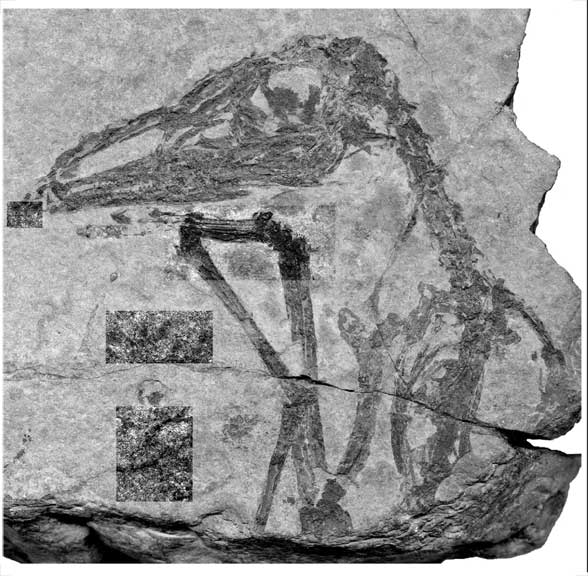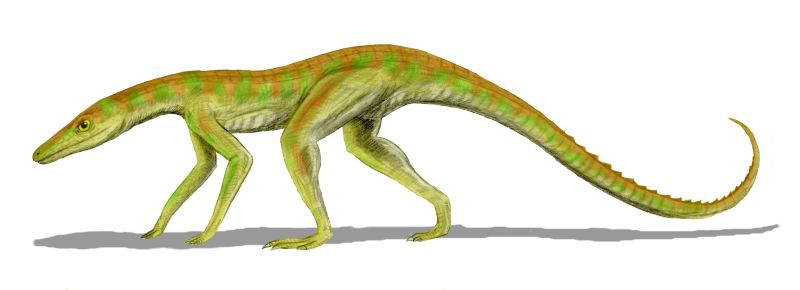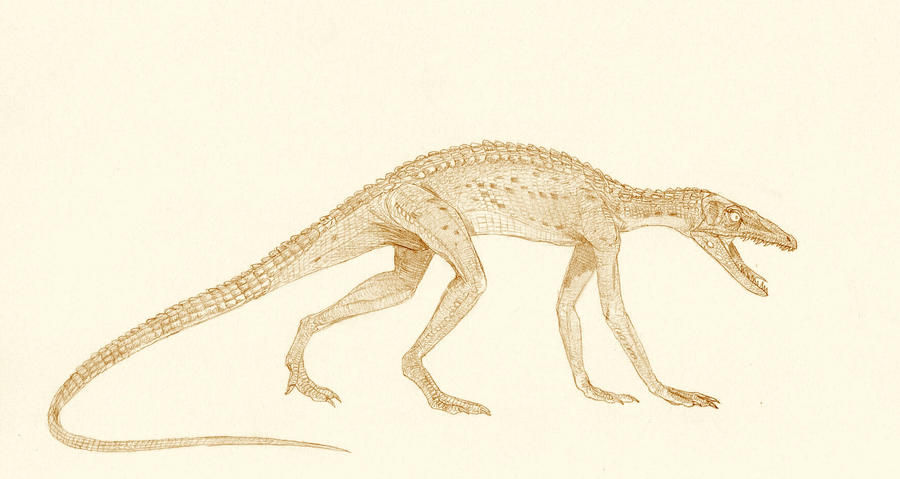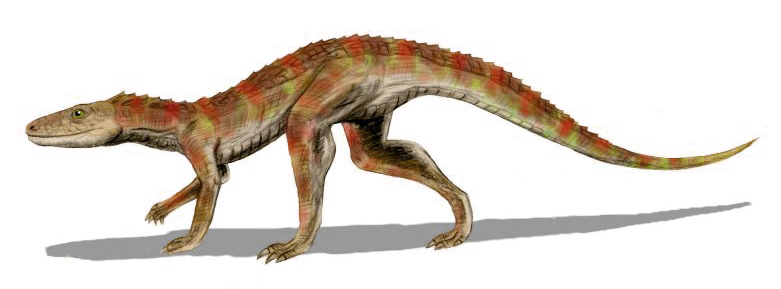[Recent Entries][Archive][Friends][User Info]
Below are 20 entries, after skipping 40 most recent ones in the "Сообщество, посвящённое ра" journal:[<< Previous 20 entries -- Next 20 entries >>]
| March 11th, 2012 | |
|---|---|
| 04:14 pm [industrialterro] [Link] |
Agnosphitys Агносфитис (Agnosphitys ) — род ящеротазовых динозавров из группы динозавроформов, живших в позднем триасовом периоде (около 228—199,6 миллионов лет назад), на территории нынешней Европы. Известен по найденным таранной и плечевой костям, ilium и maxilla. Представлен одним видом — Agnosphitys cromhallensis. Типовой вид Agnosphitys cromhallensis был описан Фрасером, Падианом, Уолкденом и Дэвисом в 2002 году. Окаменелости, состоящие из частичного скелета, были найдены в местности Avon, Англия. По кладистическому анализу Agnosphitys близок к родословной динозавров, однако точное таксономическое положение динозавра в настоящее время оспаривается учеными. Некоторые, например, Фрасер в 2002 году, относит его в группу ящеротазовых динозавров, указывает на его тесное родство с ранними динозаврами. Другие считают его динозавроморфом, близким к начальным эволюционным формам динозавров. В 2004 M. C. Langer помечает его как nomen dubium. Однако в 2010 году Эскурра дает более четкое таксономическое положение, отнеся его в семейство Guaibasauridae. Ящерота́зовые (Saurischia) — один из двух главных отрядов динозавров. Отличаются тем, что лобковые кости первично наклонены вперёд (позднее у некоторых представителей — сегнозавры, дромеозавры и другие, лобковые кости отклоняются назад). К ящеротазовым относятся: 1) Крупные растительноядные зауроподы, ходившие на четырех ногах. 2) В среднем более мелкие плотоядные тероподы, передвигавшиеся на двух задних конечностях (ранняя юра — поздний мел).
Tags: Вымершие рептилии, Триас, авеметатарзалии, архозавроморфы, архозавры, диапсиды, динозавроморфы, динозавры, ящеротазовые |
| 04:28 pm [industrialterro] [Link] |
Dinosauria Диноза́вры (Dinosauria, от др.-греч. δεινός — страшный, ужасный, опасный и σαῦρος — ящер, ящерица) — надотряд наземных позвоночных животных, доминировавших на Земле в мезозойскую эру — в течение более 160 миллионов лет, начиная с позднего триасового периода (приблизительно 225 млн лет назад) до конца мелового периода (около 65 млн лет назад), когда большинство из них стали вымирать на стыке мелового и третичного периодов во время крупномасштабного исчезновения животных и многих разновидностей растений в относительно короткий геологический период истории. Ископаемые останки динозавров обнаружены на всех континентах планеты. Ныне палеонтологами описано более 500 различных родов и более чем 1000 различных видов, которые чётко делятся на две группы — птицетазовых и ящеротазовых динозавров. Рептилии обитали на Земле ещё до появления динозавров. Лапы у них были расположены по бокам туловища, как у большинства современных ящериц. Около 300 млн лет назад во время каменноугольного периода произошло глобальное потепление, что по мнению ученых уничтожило тропические леса и вызвало эволюционный взрыв среди рептилий. Каждая популяция оказалась запертой в небольшой области обитания, и каждая начала развиваться по-своему, что и привело к увеличению разнообразия. Затем появились предки динозавров — архозавры («господствующие ящеры»). Появление архозавров шло параллельно с массовым (но не полным) вымиранием терапсид на границе перми и триаса (Массовое пермское вымирание). В начале триасового периода возникло множество новых видов. Важнейшие продвинутые признаки ранних динозавров, которые отсутствовали у большинства текодонтов, были связаны с положением тела и характером локомоции. Задние конечности становятся практически вертикальными, а их длина по сравнению с более короткими передними конечностями позволяет делать выводы о хождении на двух ногах (бипедальности). Высшие формы терапсид по своей организации были очень близки к однопроходным млекопитающим и, по некоторым предположениям, имели молочные железы и шерсть. Внезапный упадок тероморфов и расцвет «настоящих ящеров» — одна из самых интригующих загадок палеонтологии. Динозавры отклонились от своих предков архозавров спустя примерно 20 миллионов лет после Массового пермского вымирания, которое уничтожило приблизительно 95 % всей жизни на Земле. На сегодняшний день останки самых древних динозавров имеют возраст около 230 миллионов лет. Однако в 2010 году группа американских, немецких и южноафриканских палеонтологов представила в научном мире совместную работу, согласно с которой первые динозавры населяли Землю на несколько миллионов лет раньше, нежели было принято считать. Свои выводы они сделали проанализировав останки новой динозаврообразной рептилии Asilisaurus kongwу, которая является родственным динозаврам видом, жившим 245—240 млн лет назад. Учёные говорят, что уже в это время различия между Dinosauriformes и самыми ранними динозаврами были существенными, следовательно, общий предок динозавров отделился от группы Ornithodira существенно раньше, чем считалось прежде. По одной из гипотез, оба отряда динозавров впервые появились на территории современной Южной Америки и затем распространились по всей Пангее в течение триасового периода с 230 до 199 миллионов лет назад. ( Далее ) Tags: Вымершие рептилии, Триас, авеметатарзалии, архозавроморфы, архозавры, диапсиды, динозавроморфы, динозавры |
| March 10th, 2012 | |
| 02:33 pm [industrialterro] [Link] |
Silesaurus Silesaurus is a genus of dinosauriform from the Late Triassic, approximately 230 million years ago in the Carnian faunal stage of what is now Poland. Fossilized remains of Silesaurus have been found in the Keuper Claystone in Krasiejów near Opole, Silesia, Poland, which is also the origin of its name. The type species, Silesaurus opolensis, was described by Jerzy Dzik in 2003. It is known from some 20 skeletons, making it one of the best-represented of the early dinosaurs and related animals. Silesaurus measured approximately 2.3 meters long (7.5 ft), and was facultatively bipedal. It was light and built for speed. Silesaurus was a herbivore. The teeth were small, conical, and serrated. The tip of the dentary has no teeth, and some paleontologists think that it may have been covered by a beak. Most scientists think that Silesaurus was not a dinosaur, but rather a dinosauriform. Dinosaurian features lacking in Silesaurus include an enlarged deltopectoral crest (a muscle attachment on the humerus), and epipophysis (enlarged tendon attachment above the postzygapophysis) on the cervical vertebrae. However, Silesaurus has some dinosaurian characteristics as well:
As a result, alternative theories place Silesaurus at or near the base of the ornithischian dinosaurs. Other scientists propose a basal link between the prosauropods and ornithischians.
Tags: Вымершие рептилии, Триас, авеметатарзалии, архозавроморфы, архозавры, диапсиды, динозавроморфы, силезавриды |
| 02:21 pm [industrialterro] [Link] |
Sacisaurus Sacisaurus (referred to in Portuguese as sacissauro) is a dinosauriform from the Late Triassic (Carnian to Norian) Caturrita Formation of southern Brazil. The scientific name refers to the city where the Sacisaurus was found, Agudo in the Rio Grande do Sul state and to Saci, a famous one-legged elf from Brazilian mythology, because the fossil skeleton has been found missing a leg. It was discovered in the geopark of Paleorrota. Sacisaurus was 1.5 meters (5 ft) long and 70 centimeters (2.3 ft) high. Its long and strong legs indicate that it was a fast animal. According to Jorge Ferigolo, paleontologist of Zoobothanic Foundation of Rio Grande do Sul state, the biggest teeth of the genus were 3 millimeters (1/12 in) long. The well-preserved jaw indicates that Sacisaurus was an herbivore, and there is a process at the tip that resembles the ornithischian predentary bone. Further research will attempt to define if Sacisaurus was the oldest ornithischian dinosaur. Through the cladistic analysis of some of its morphological particularities, its closest relative may be Diodorus. Sacisaurus was discovered in 2001 in the small municipality of Agudo, in the countryside of Rio Grande do Sul state. Through 50 bones, scientists could assemble the skeleton and speculate on how it might have lived. The fossil was presented for the first time in the 2nd Latin American Congress of Vertebrate Paleonthology in 2005. After the work of Brazilian scientists, the announcement of the discovery of the new species was made on November 1, 2006 at the University of São Paulo, Ribeirão Preto, where the bones were identified and the paper was published in the British scientific journal Historical Biology: A Journal of Paleobiology on October 30, 2006. The discovery helped scientists to study the feeding habits of dinosaurs and their close relatives, since it is one of the oldest ever found.
Tags: Вымершие рептилии, Триас, авеметатарзалии, архозавроморфы, архозавры, диапсиды, динозавроморфы, силезавриды |
| 02:16 pm [industrialterro] [Link] |
Lewisuchus Lewisuchus is a genus of archosaur that lived during the Middle Triassic (Ladinian); it was a silesaurid dinosauriform, a member of the group of reptiles which lead to the dinosaurs. Lewisuchus was about three feet long. Fossils have been found in Argentina. Some of the fossils originally assigned to Lewisuchus have since been moved to other genera, and the remaining portions closely resemble those of Pseudolagosuchus. A 2010 study in the Journal Nature indicated that the two may be synonymous. They were approximately the same size and came from the same locality and strata, but the fossil material is fragmentary and there is very little overlapping material. Since Lewisuchus was described 15 years before Pseudolagosuchus, if it is shown the two are synonymous (through the discovery of additional fossils) the name Lewisuchus would have priority.
Tags: Вымершие рептилии, Триас, авеметатарзалии, архозавроморфы, архозавры, диапсиды, динозавроморфы, силезавриды |
| 01:50 pm [industrialterro] [Link] |
Asilisaurus Asilisaurus ( Fossils were uncovered in Tanzania and date back to the Anisian stage of the Middle Triassic. It was described in 2010 by a team of researchers from the United States, Germany, and South Africa, in the journal Nature; the type species is A. kongwe. It is the first example of an avian-line radiation during the Anisian, with the diversification of archosaurs during this time previously only documented from crocodylian-line archosaurs. It was the first non-dinosaurian dinosauriform recovered from Africa. Asilisaurus measured from 1 to 3 metres (3 to 10 ft) long and 0.5 to 1 metre (2 to 3 ft) high at the hip, and weighed 10 to 30 kilograms (20 to 70 lb). Ученые нашли окаменелые останки самого древнего животного, образующего с динозаврами одну эволюционную ветвь, что говорит о более раннем, примерно на 10-15 миллионов лет, отделении предков динозавров от других типов животных, обитавших на доисторической Земле, сообщается в статье исследователей, опубликованной в четверг в журнале Nature. Обнаруженный вид животных получил название Asilisaurus kongwe - от asili ("предок" или "основание" на языке суахили), sauros ("ящер" на греческом ) и kongwe ("древний" на языке суахили). Он относится к животным из не так давно открытой группы силезавров (silesaurs), состоящих примерно в таком же родстве с динозаврами, в каком человек состоит с самыми близкими своими родственниками - шимпанзе. Асилизавр, по мнению ученых, жил примерно 243 миллиона лет назад, тогда как останки самого древнего динозавра, обнаруженные на данный момент, имеют возраст всего 230 миллионов лет. Это говорит о том, что общий предок динозавров отделился от остальных примитивных ящеров, потомками которых являются, например, современные крокодилы, существенно раньше, чем считалось прежде - около 250 миллионов лет назад. Асилизавры жили бок о бок с динозаврами на протяжении всего триасового периода - с 250 до 200 миллионов лет назад. Ученые теперь полагают, что другие родственники динозавров, такие, например, как летающие ящеры, тоже появились раньше, чем принято считать. Асилизавры были распространены на всех континентах мира, составлявших тогда единый суперматерик Пангею. Ведя раскопки в Танзании, авторы статьи - группа палеонтологов во главе со Стирлингом Несбиттом (Sterling Nesbitt) из Техасского университета в США, обнаружили останки сразу 14 особей асилизавров. Это позволило ученым практически полностью восстановить облик древнего родственника ископаемых рептилий. Асилизавр передвигался на четырех конечностях, был небольших размеров - не более 3 метров от кончика носа до кончика длинного хвоста, составлявшего до половины длины всего тела, и весил от 10 до 30 килограммов. У него была вытянутая морда с нижней челюстью, снабженная заостренным ороговевшим кончиком и рядом треугольных зубов. Авторы статьи полагают, что характерные черты асилизавра указывают на то, что это было травоядное или всеядное животное. До сих пор палеонтологи считали, что наиболее близкие предки динозавров были сугубо хищными животными и передвигались на двух лапах. "Асилизавр несет на себе черты, сильно отличающиеся от тех, что мы ожидали увидеть у родственника первых динозавров, особенно это касается его способности употреблять растительную пищу и перемещаться на четырех лапах", - сказал соавтор публикации Рэнделл Ирмис (Randall Irmis) из Университета Юты, слова которого приводит пресс-служба учебного заведения. Тот факт, что общие предки асилизавров и динозавров были сугубо хищными животными, указывает на три различных независимых пути эволюции и появления травоядных среди этих групп животных в течение всего 10 миллионов лет. Другими группами животных, освоившими питание растениями в этот период времени, были птицетазовые динозавры и динозавры из группы зауроподоморфов. Ученые полагают, что способность питаться растительной пищей дала животным эволюционные преимущества перед конкурентами, так как экосистема тех времен была представлена в основном хищниками, находившимися друг с другом в сильной конкуренции. Останки асилизавров были обнаружены среди останков других типов животных - примитивных родственников современных крокодилов, что говорит о более раннем и быстром разделении эволюционных ветвей этих животных, чем считалось прежде. "Наше исследование заставляет предположить, что в то время, примерно 250 миллионов лет назад, существовало больше групп животных, которые нам еще предстоит обнаружить. Чем больше мы о них узнаем, тем больше мы понимаем о появлении и эволюции самих динозавров и других групп животных", - подытожил Ирмис. Значимость открытия Asilisaurus kongwe не только в том, что он проливает свет на раннюю эволюцию силезавров, но и в том, что он позволяет лучше понять эволюцию всей группы динозавроморфных архозавров. Ранее палеонтологи предполагали, что все предки динозавров и их ближайшие родственники в начале и середине триаса были хищниками и, преимущественно, двуногими. Но открытие силезавров и вот теперь обнаружение Asilisaurus kongwe показало, что экологическое разнообразие внутри группы орнитодир (Ornithodira) в триасе было значительно большим. Здесь необходимо пояснить, что орнитодиры – большая группа архозавров, в которую ученые объединяют птерозавров, динозавроморфных архозавров, а некоторые – сторонники теории происхождения птиц от динозавров - добавляют в нее и птиц. The fossils range in age from the Anisian to the Norian stages of the Triassic, about 245 to 203 million years ago. Among the members of the Silesauridae were Silesaurus (which lends its name to the family), Pseudolagosuchus, Lewisuchus, Asilisaurus, Technosaurus, Eucoelophysis, Sacisaurus, and Diodorus.
Размеры тела в сравнении с человеком:
Tags: Вымершие рептилии, Триас, авеметатарзалии, архозавроморфы, архозавры, диапсиды, динозавроморфы, силезавриды |
| 01:30 pm [industrialterro] [Link] |
Lagosuchus Лагозух (Lagosuchus) — древнее животное, обитавшее в триасовый период. Часть учёных считает его связующим звеном, от которого произошли такие динозавры, как один из самых первых — ставрикозавр. Название, придуманное американским палеонтологом Альфредом Шервудом Ромером (1894—1973), означает «прыгающий крокодил». Его окаменелости были обнаружены в Ла-Риохе (Аргентина). Лагозух был размером с кролика, а также схож с ним строением задних конечностей. Передние конечности Лагозуха приспособлены для захвата добычи. По другим характеристикам схож с динозаврами, имел длинный тонкий хвост и длинные ноги, что свидетельствует о том, что он мог быстро и прытко перемещаться. Лагозухи были хищниками, питались всевозможными насекомыми. Возможно, они также были способены набрасываться на небольших животных, используя свои длинные задние конечности, которые с большой скоростью толкали их вперед. Когда лагозух быстро бежал, он, по всей видимости, опирался лишь на задние конечности, но иногда передвигался и на всех четырёх. Возможно, лагозух был настолько проворным, что мог забираться на деревья, когда ему грозила опасность, и иногда заходить в неглубокую воду, хотя не имеется никаких признаков того, что он хорошо плавал. В триасовом периоде, когда жил лагозух, вся суша представляла собой единый гигантский сверхматерик Пангею, климат был жарким и шли проливные дожди, за исключением внутренних районов, где образовались пустыни. Основной растительностью являлись гинкго, саговники, хвойные деревья, хвощи и папоротники.
Tags: Вымершие рептилии, Триас, авеметатарзалии, архозавроморфы, архозавры, диапсиды, динозавроморфы |
| 01:21 pm [industrialterro] [Link] |
Marasuchus Маразух (Marasuchus) — вымерший род архозавров отнесенный к кладу орнитодиры, живший в среднем триасе. Является ближайшим родственником динозавров. Окаменелости были обнаружены в Аргентине (Южная Америка). В длину достигал до 1,3 метров. В строении скелета этой рептилии много общих с динозаврами особенностей. Например, передние лапы у маразуха были почти вдвое короче задних. Лёгкий и, вероятно, очень проворный, маразух мог передвигаться на двух задних ногах не хуже, чем на всех четырёх. Питался он, по-видимому, мелкими рептилиями и насекомыми.
Tags: Вымершие рептилии, Триас, авеметатарзалии, архозавроморфы, архозавры, диапсиды, динозавроморфы |
| 01:01 pm [industrialterro] [Link] |
Dromomeron Dromomeron (meaning "running femur") is a genus of lagerpetonid dinosauromorph archosaur from Late Triassic-age rocks of the Southwestern United States. It is known from partial remains, largely from the hindlimbs, which indicate an animal with an overall length of less than 1.0 meters (3.3 ft). It is described as most closely related to the earlier Lagerpeton of Argentina, but was found among remains of true dinosaurs like Chindesaurus, indicating that the first dinosaurs did not immediately replace related groups. Dromomeron and type species D. romeri is based on GR 218, a complete left thigh bone from the Hayden Quarry at Ghost Ranch, New Mexico. The rocks there are in the lower portion of the Petrified Forest Member of the Chinle Formation, and are Norian in age. Additional hindlimb bones, some probably from the same individual, are also known, and a partial skeleton has been recovered from Hayden Quarry, but has not yet been fully prepared. A few other specimens have been recovered from nearby localities, including the Snyder Quarry. The bones of Dromomeron are most similar to those of the older dinosauromorph Lagerpeton, and the two animals have been classified together in a clade Lagerpetonidae. The species name romeri honors influential 20th century vertebrate paleontologist Alfred Sherwood Romer. Also found at the Hayden Quarry are the remains of phytosaurs, aetosaurs, rauisuchians, and several types of dinosaurs and dinosaur relatives, including a Silesaurus-like animal, the herrerasaurid Chindesaurus, and an unnamed coelophysoid theropod. Finding the remains of four types of dinosaurs and dinosaur relatives (including Dromomeron itself) is noteworthy because it shows that dinosaurs did not immediately replace related groups; that some of these groups, like the lagerpetonids, persisted for longer than previously known and diversified; and that dinosaurian replacement may have occurred at different times in different areas. Other specimens from the Chinle Formation of Arizona and a roughly contemporaneous part of the Dockum Group of Texas also have been assigned to this genus. These have been assigned to second species D. gregorii, named in 2009. D. gregorii, named for Joseph T. Gregory, is based on TMM 31100–1306, a right femur (thigh bone) from the Otis Chalk Quarry, Colorado City Formation, (Dockum Group), near Otis Chalk, Texas. Several other limb bones from the quarry, and a partial femur (thigh bone) from the Placerias Quarry of eastern Arizona have been assigned to this species. The rocks D. gregorii is known from are older than those D. romeri has been found in. As with D. romeri, the Otis Chalk Quarry also has at least one specimen of the early dinosaur Chindesaurus. The Lagerpetonidae (LAJ•er•pet•ON•ih•DÆ) is a family of basal dinosauromorphs. Members of the family are known from the Late Triassic of Argentina, Arizona, New Mexico, and Texas. Lagerpetonids are defined as being rather small (length of one hind limb being 25 centimetres (9.8 in)), with "very marked locomotor specializations", final presacral and anteriorly oriented vertebrae, a sacral including two vertebrae, a closed acetabulum, and an up facing ilium". They had a short and wide pubis, and had an ischium with extensive ventral lamina. In relation to the genus Lagosuchus, the genera had shorter thigh bones than shins. Динозавроморфы (Dinosauromorpha) — группа вымерших архозавров, близких к динозаврам, живших в триасовом периоде на территории Европы, Северной и Южной Америки. В некоторых классификациях к этой группе также относятся и сами динозавры. Название кладе дано M. J. Benton в 1985 году, которую он отнес к группе Neoarchosauria. Однако через год, в 1986 году, Жаком Готье динозавроморфы были отнесены в новую кладу — Ornithodira. Впоследствии остальные ученые поддержали данный таксон. Ныне таксономическое положение Neoarchosauria не определено. Базальные динозавроморфы не являлись непосредственными предками динозавров. Ранее предполагалось, что динозавроморфы вымерли в то время, когда начался быстрый расцвет динозавров. Однако найденные останки примитивных динозавроморф вместе с останками первых динозавров, в отложениях триаса в штате Нью-Мексико, дает основание полагать, что базальные динозавроморфы и динозавры сосуществовали одновременно. По-видимому, в триасе динозавры выдержали долгую конкуренцию с динозавроморфами, прежде чем победили и достигли расцвета в юрском периоде. Также палеонтологи предполагали, что все предки динозавров и их ближайшие родственники из группы динозавроморфных рептилий в начале и середине триаса были хищниками и, преимущественно, двуногими. Но открытие силезавров и обнаружение Asilisaurus kongwe показало, что экологическое разнообразие внутри группы орнитодир (Ornithodira) в триасе было значительно большим. Ornithodira (Avemetatarsalia) — клада в рамках более широкой группы архозавров. В 1986 году Жак Готье дал название Ornitodira, содержащей общих предков динозавров, птерозавров и их ближайших родственников. В 1991 году Пол Серено дополнил кладистику и включил в нее Scleromochlus и расширил таким образом кладу Готье. Однако в 1999 году Майкл Бентон пришел к выводу, что Scleromochlus не родственен с другими животными клады Ornithodira. В 2004 году Бентон дал более чёткое определение клады Ornithodira.
Tags: Вымершие рептилии, Триас, авеметатарзалии, архозавроморфы, архозавры, диапсиды, динозавроморфы, лагерпетониды |
| 12:42 pm [industrialterro] [Link] |
Preondactylus Preondactylus is a genus of long-tailed pterosaur from the Late Triassic that inhabited what is now Italy. It was discovered by Nando Buffarini in 1982 near Udine in the Preone valley of the Italian Alps. Preondactylus had single cusp teeth, meaning they had one point on each tooth. Its diet either consisted of fish, insects or both, but there is still debate going on as the tooth structure could indicate either diet (or both). It had short wings, whose total span was only 45 cm (18 in), and relatively long legs. The short wings were a "primitive" feature for pterosaurs, but Preondactylus was a fully developed flier. When Buffarini first discovered Preondactylus, the thin slab of bituminous, dolomitic limestone containing the fossil was accidentally broken into pieces while being extracted. After reassembly the rock was cleaned with water by him and his wife and the marl and in it the bone was washed away and lost. All that was left was a negative imprint on the stone, of which a silicon rubber cast was made to allow for subsequent study of the otherwise lost remains. Most of the skeleton is known, but the posterior portions of the skull have not been preserved. This first specimen is the holotype: MFSN-1891. A second, disarticulated specimen, MFSN-1770, was found at the same locale in 1984 about 150-200 meters deeper into the strata than the original find. The second specimen appears to have been preserved in the gastric pellet of a predatory fish, which had consumed the pterosaur and vomited up the indigestible pieces that would later fossilize. More detailed knowledge of the variability of Triassic pterosaurs has made the identification of this specimen as Preondactylus uncertain. A third specimen is MFSN 25161, a partial skull, lacking the lower jaws. The species was described and named by Rupert Wild in 1984. The genus name refers to Preone, the specific name honours Buffarini. Rupert classified the new species within Rhamphorhynchidae, of which group very old species are known such as Dorygnathus, but soon it was understood the form was much more basal. A cladistic analysis by David Unwin found Preondactylus as the most basal pterosaur, and the species was accordingly used by him for a node clade definition of the clade Pterosauria. Other analyses however, have found a somewhat more derived position for Preondactylus.
Tags: Вымершие рептилии, Триас, авеметатарзалии, архозавроморфы, архозавры, диапсиды, птерозавры, рамфоринхоидеи |
| 12:23 pm [industrialterro] [Link] |
Peteinosaurus Peteinosaurus (pronounced /pɛˌtaɪnəˈsɔrəs/ or /pɛˌtinəˈsɔrəs/) was a prehistoric reptile genus belonging to the Pterosauria. It lived in the late Triassic period in the middle Norian (about 221-210 million years ago). Three fossils have been found near Cene, Italy. The first fossil, the holotype MCSNB 2886, is fragmentary and disarticulated. The second, the articulated paratype MCSNB 3359, lacks any diagnostic features of Peteinosaurus and thus might be a different species. This paratype has a long tail (20 cm) made more stiff by long extensions of the vertebrae; this feature is common among pterosaurs of the Triassic. The third exemplar is MCSNB 3496, another fragmentary skeleton. All specimina are those of subadults and of none has the skull been preserved. Like most pterosaurs, Peteinosaurus had bones that were strong but very light. Peteinosaurus is trimorphodontic, with three types of conical teeth. An insectivorous lifestyle has been attributed to Peteinosaurus. The fifth toe of Peteinosaurus was long and clawless. Its joint allowed it to flex in a different plane than the other phalanges, an adaptation whose function is unknown. Peteinosaurus is one of the oldest-known pterosaurs, and at a mere sixty centimetres, had a tiny wingspan when compared to some later genera, such as Pteranodon whose wingspan exceeded twenty feet. Its wings were also proportionally smaller than those of later pterosaurs, as its wing length was only twice the length of the hindlimb. All other known pterosaurs have wingspans at least three times the length of their hindlimbs. It also had single cusped teeth that lacked the specialized heterodonty present in the other Italian Triassic pterosaur genus, Eudimorphodon. All these factors converge to hint that Peteinosaurus belongs to a group that possibly represents the most basal known pterosaurs: the Dimorphodontidae, to which it was assigned in 1988 by Robert L. Carroll. The only other known member of that group is the later genus Dimorphodon, which lent its name to the family including both genera. Later cladistic analyses however, have not shown a close connection between the two forms. Nevertheless the possible basal position of Peteinosaurus has been affirmed by Fabio Marco Dalla Vecchia who suggested that Preondactylus, according to David Unwin the most basal pterosaur, might be a subjective junior synonym of Peteinosaurus. A 2010 cladistic analysis by Brian Andres and colleagues placed Peteinosaurus in Lonchognatha which includes Eudimorphodon and Austriadactylus as more basal.
Tags: Вымершие рептилии, Триас, авеметатарзалии, архозавроморфы, архозавры, диапсиды, диморфодонтиды, птерозавры, рамфоринхоидеи |
| March 9th, 2012 | |
| 05:20 pm [industrialterro] [Link] |
Eudimorphodon Eudimorphodon was a pterosaur that was discovered in 1973 by Mario Pandolfi near Bergamo, Italy and described the same year by Rocco Zambelli. The nearly complete skeleton was retrieved from shale deposited during the Late Triassic (mid to late Norian stage), making Eudimorphodon the oldest pterosaur then known. It had a wingspan of about 100 centimetres (3.3 ft) and at the end of its long bony tail may have been a diamond-shaped flap like in the later Rhamphorhynchus. If so, the flap may have helped it steer while maneuvering in the air. Eudimorphodon is known from several skeletons, including juvenile specimens. Eudimorphodon showed a strong differentiation of the teeth, hence its name, which is derived from ancient Greek for "true dimorphic tooth". It also possessed a large number of these teeth, a total of 110 of them densely packed into a jaw only six centimeters long. The front of the jaw was filled with fangs, per side four in the upper jaw, two in the lower jaw, that rather abruptly gave way to a line of smaller multipointed teeth, 25 in the upper jaw, 26 in the lower jaw, most of which had five cusps, others three or even four. The morphology of the teeth are suggestive of a piscivorous diet, which has been confirmed by preserved stomach contents containing the remains of fish of the genus Parapholidophorus. Young Eudimorphodon had slightly differing dentition with fewer teeth and may have had a more insectivorous diet. The top and bottom teeth of Eudimorphodon came into direct contact with each other when the jaws were closed, especially at the back of the jaw. This degree of dental occlusion is the strongest known among pterosaurs. The teeth were multi-cusped, and tooth wear shows that Eudimorphodon was able to crush or chew its food to some degree. Wear along the sides of these teeth suggests that Eudimorphodon also fed on hard-shelled invertebrates. Despite its great age Eudimorphodon has few primitive characteristics making the taxon of little use in attempting to ascertain where pterosaurs fit in the reptile family tree. Basal traits though, are the retention of pterygoid teeth and the flexibility of the tail, which lacks the very long stiffening vertebral extensions other long-tailed pterosaurs possess. Paucity of early pterosaur remains has ensured that their evolutionary origins continues to be a persiseant mystery with some experts suggesting affinities to dinosaurs, archosauriformes, or prolacertiformes. Within the standard hypothesis that the Dinosauromorpha are the pterosaurs' close relatives within an overarching Ornithodira, Eudimorphodon is also unhelpful in establishing relationships within Pterosauria between early and later forms because then its multicusped teeth should be considered highly derived, compared to the simpler single-cusped teeth of Jurassic pterosaurs, and a strong indicator that Eudimorphodon is not closely related to the ancestor of later pterosaurs. Instead it is believed to be a member of a specialized off branch from the main "line" of pterosaur evolution, the Campylognathoididae. Eudimorphodon currently includes two species. The type species, E. ranzii, was first described by Zambelli in 1973. It is based on holotype MCSNB 2888. The specific name honours Professor Silvio Ranzi. A second species, E. rosenfeldi, was named by Dalla Vecchia in 1995 for two specimens found in Italy. However, further study by Dalla Vecchia found that these actually represented a distinct genus, which he named Carniadactylus in 2009. One additional species is still currently recognized: E. cromptonellus, described by Jenkins and colleagues in 2001. It is based on a juvenile specimen with a wing span of just 24 centimeters, MGUH VP 3393, found in the early nineties in Greenland. Its specific name honors Professor Alfred W. Crompton; the name is a diminutive because the exemplar is so small. In 1986 fossil jaw fragments containing multicusped teeth were found in Dockum Group rocks in western Texas. One fragment, apparently from a lower jaw, contained two teeth, each with five cusps. Another fragment, from an upper jaw, also contained several multi-cusped teeth. These finds are very similar to Eudimorphodon and may be attributable to this genus, although without better fossil remains it is impossible to be sure.
Репродукции (1, 2, 3, 4, 5, 6, 7, 8, 9):
( Далее )
Tags: Вымершие рептилии, Триас, авеметатарзалии, архозавроморфы, архозавры, диапсиды, птерозавры, рамфоринхоидеи |
| 05:06 pm [industrialterro] [Link] |
Caviramus Caviramus is a genus of "rhamphorhynchoid" pterosaur from the Late Triassic (late Norian-early Rhaetian-age) lower Kössen Formation of the Northern Calcareous Alps of Switzerland. The genus was in 2006 named by Nadia Fröbisch and Jörg Fröbisch. The type species is Caviramus schesaplanensis. The genus name is derived from Latin cavus, "hollow" and ramus, "branch". The specific name refers to Mount Schesaplana. The genus is based on holotype PIMUZ A/III 1225, three non-contiguous fragments of a ramus (lower jaw) of the mandible with multicuspate teeth. Two teeth are preserved, one with three cusps, and one with four; despite this difference the authors consider them as essentially isodont. The number of teeth is estimated at a minimum of twelve and a maximum of seventeen. A row of large oval foramina runs parallel to the tooth row; foramina in the form of small holes in the anterior part of the lower jaw suggest some sort of soft-tissue structure, or a keratin covering. The jaw is light and hollow. The teeth of this genus resemble those of Eudimorphodon, but the jaw is different. The discovery of this genus is a find of some significance, as there are few pterosaurs known from the Triassic. A second specimen, originally assigned to its own genus and species as Raeticodactylus filisurensis, consists of a single disarticulated partial skeleton including an almost complete skull. The skull shows that it had a tall thin bony crest running along the midline of the front of the upper jaw, and a keel on the lower jaw. The teeth at the front of the upper jaw, in the premaxillae, were fanglike, whereas the teeth in the upper cheeks (the maxillae) had three, four, or five cusps, similar to those of Eudimorphodon. Caviramus had a wingspan of about 135 centimeters (53 in), and may have been a piscivore, potentially a dip-feeder. Despite the resemblance to Eudimorphodon the authors classified Caviramus as Pterosauria incertae sedis. A 2009 study by Fabio Dalla Vecchia concluded that Raeticodactylus, which is known from a more complete skeleton including lower jaw, probably belong to the same genus, and possibly the same species, if the differences (such as size and the presence of a crest in the Raeticodactylus specimen) are not due to sex or age. Subsequent studies have supported their synonymy. Dalla Vecchia found the two forms in a sister clade of Carniadactylus, implying that Caviramus was a member of the Campylognathoididae.
Tags: Вымершие рептилии, Триас, авеметатарзалии, архозавроморфы, архозавры, диапсиды, птерозавры, рамфоринхоидеи |
| 04:55 pm [industrialterro] [Link] |
Austriadactylus Austriadactylus is a genus of "rhamphorhynchoid" pterosaur. The fossil remains were unearthed in Late Triassic rocks of Austria. The genus was named in 2002 by Fabio Marco Dalla Vecchia e.a.. The type species is Austriadactylus cristatus. The genus name is derived from Latin Austria and Greek daktylos, "finger", in reference to the wing finger of pterosaurs. The specific epithet means "crested" in Latin, a reference to the skull crest. The genus is based on holotype SMNS 56342, a crushed partial skeleton on a slab, found in an abandoned mine near Ankerschlag in Tirol, in the Norian Seefelder Beds. The counterslab has been lost and with it some of the bone. The fossil consists of the skull, lower jaws, some vertebrae, parts of the limbs and pelvic girdle, and the first part of the tail. The elongated skull has a length of eleven centimetres. It carried a bony crest that widened as it descended towards the snout, up to height of two centimetres. The triangular nares formed the largest skull openings. The also triangular fenestrae antorbitales are smaller that the orbits. The teeth differ in shape and the species was thus heterodont. Most teeth are small and tricuspid or three-pointed. In the front of the upper jaw five larger recurved teeth with a single point form a prey grab; six or seven such teeth are also interspersed with the smaller teeth more to the back of the mouth. There are at least seventeen and perhaps as much as 25 tricuspid teeth in the upper jaw, for a total of perhaps 74 teeth of all sizes in the skull. The number of teeth in the lower jaws cannot be determined. The flexible tail did not have the stiffening rod-like vertebral extensions present in other basal pterosaurs. The wingspan has been estimated at about 120 centimetres. Austriadactylus was in 2002 assigned by the describers to a general Pterosauria incertae sedis, but some later analyses showed it to have been related to Campylognathoides and Eudimorphodon in the Campylognathoididae. It has even been suggested it was a junior synonym of Eudimorphodon, though perhaps a distinct species in that genus.
Tags: Вымершие рептилии, Триас, авеметатарзалии, архозавроморфы, архозавры, диапсиды, птерозавры, рамфоринхоидеи |
| 04:27 pm [industrialterro] [Link] |
Scleromochlus Scleromochlus is an extinct genus of small avemetatarsalian from the Late Triassic period. A lightly built cursorial animal, its phylogenetic position has been debated; as different analyses have found it to be either the basal-most ornithodiran, the sister-taxon to Pterosauria, or a basal member of Avemetatarsalia that lies outside of Ornithodira. Scleromochlus is a monotypic genus (single species), which is the type species S. taylori. Scleromochlus taylori was about 181 mm (about 7.1 inches) long, with long hind legs; it may have been capable of four-legged and two-legged locomotion. Its fossils have been found in the Carnian Lossiemouth Sandstone of Scotland. The holotype is BMNH R3556, a partial skeleton preserved as an impression in sandstone; part of the skull and tail are missing. Птероза́вры (Pterosauria — «летающие ящеры») — отряд вымерших летающих архозавров. Жили в мезозое на протяжении более 200 млн лет. Последние представители относятся ко времени вымирания динозавров, около 65 млн лет назад. В середине XVIII в. учёные извлекли из юрских зольнхофенских известняков (Бавария, Германия) несколько полных скелетов небольшого животного. Это существо настолько отличалось от всех современных животных, что долгие годы учёные терялись в догадках, что это за животное. Одни сочли его неведомой уткой, другие — летучей мышью и даже миниатюрным драконом. И только в 1809 году великий французский зоолог и палеонтолог Жорж Кювье окончательно установил, что найденные скелеты принадлежали вымершей летающей рептилии. Кювье назвал её птеродактилем («пальцекрыл»). Позднее, в XIX веке вокруг птерозавров развернулась ещё одна дискуссия. Ведущие британские учёные того времени Ричард Оуэн и Гарри Сили спорили о том, были ли птерозавры холоднокровными рептилиями или теплокровными «примитивными птицами». Картину прояснили последующие ископаемые находки. Без сомнения, птерозавры являлись рептилиями (как и полагал Оуэн), но теплокровными. Размах крыльев птерозавров достигал 7 метров, что более чем вдвое превышает этот показатель у любой из ныне живущих птиц. Их крылья представляли собой складки кожи, натянутые между боками тела и очень длинным четвёртым пальцем передних конечностей. Скелет обладал облегченной конструкцией: тонкие полые кости, лёгкий череп почти что сетчатой структуры, грудина имела киль, как у птиц. Строение скелета крыльев и плечевого пояса указывает на наличие мощной махательной мускулатуры. Необходимость в полёте возникла в связи с питанием рыбой и трупами, плавающими в воде, но птерозавры питались также и насекомыми. В настоящее время споры о способности птерозавров летать не утихают. Одни специалисты полагают, что гигантские рептилии могли преодолевать огромные расстояния по воздуху, а другие утверждают, что если и могли, то лишь в тихую погоду. На полуводный образ жизни указывают перепончатые лапы. Вытянутые в клюв челюсти могли нести зубы. У некоторых поздних форм, например, птеранодонов, были беззубые челюсти. Зубы некоторых видов свидетельствуют о питании планктоном. Птерозавры имели достаточно хорошо развитый мозг (преимущественно за счет мозжечка, отвечающего за координацию движений) и острое зрение. У них были редуцированны (уменьшены) обонятельные доли и развиты зрительные доли, что говорит о том, что летучих ящеров больше интересовало, как что-то выглядело, нежели как оно пахло. Тело было покрыто своеобразной «шерстью», что позволяет делать предположения о теплокровности птерозавров. На теплокровность указывает и обильное кровоснабжение костей, подобное тому, что наблюдается у птиц и млекопитающих. Возможно, что «шерсть» — это «пуховое оперение» молодых животных, так как у многих видов (например, Eudimorphodon) следы власоподобных структур обнаружены только на останках молодых особей. Птерозаврам для целей минимизации проблем с терморегуляцией при полноценном бодрствовании в светлое время суток просто необходимо было иметь многослойную, сложно устроенную мембрану крыла с развитой сосудистой сетью, обеспечивающей кондиционирование, а также наружные покровы, способные защитить от попадания избыточного количества прямых и отражённых солнечных лучей (например, во время полётов над водой), и гарантировать доставку крови к голове одной и той же температуры. По причине высокой специализации анатомии птерозавров для полета и отсутствия на данный момент известных переходных эволюционных форм, предки этих рептилий до конца не понятны. По некоторым гипотезам, они происходят от орнитодир, таких как Scleromochlus, относящихся к Avemetatarsalia близких к эупаркерии или же от проторозавров (особенно примечательным в этом предположении является вид шаровиптерикс).
Репродукции (1, 2, 3, 4, 5, 6):
Tags: Вымершие рептилии, Триас, авеметатарзалии, архозавроморфы, архозавры, диапсиды, птерозавры |
| March 8th, 2012 | |
| 12:26 pm [industrialterro] [Link] |
Terrestrisuchus Terrestrisuchus ('land crocodile') is an extinct genus of early crocodylomorph that was about 50 cm (1 ft 8 in) long. Fossils have been found in Wales and date from the Late Triassic. Terrestrisuchus was a small, thin, lizard-like creature with long legs, bearing little to no resemblance to modern crocodiles, which are its distant relatives. The shape of the legs suggests that it was able to run fast. Its tail was particularly long, about twice the length of the head and body combined, and may have been used as a balance allowing the animal to rear up and run on its hind legs alone for brief periods. The legs were positioned directly beneath the body, meaning ancestral crocodiles such as Terrestrisuchus were cursorial and thus, their legs worked as pairs for galloping. Pseudo-galloping can be seen in modern crocodiles as they are known to use paired walking in rare but speed-dependent situations. Fossil evidence also shows that they were digitigrade, supporting their weight on only digits, or fingers. Some paleontologists suggest that Terrestrisuchus may be juvenile Saltoposuchus.
Tags: Вымершие рептилии, Триас, архозавроморфы, архозавры, диапсиды, крокодиломорфы, круротарзы, равизухии, сфенозухии |
| 11:58 am [industrialterro] [Link] |
Saltoposuchus Saltoposuchus is an extinct genus of small (3–5 feet), long- tailed crocodylomorph reptile (Sphenosuchia), from the Norian (Upper Triassic) of Europe. The name translated means "leaping crocodile". It has been proposed that Terrestrisuchus gracilis and Saltoposuchus connectens represent different ontogenetic stages of the same genus. In which case, the name Saltoposuchus would take precedence over Terrestrisuchus (1984). However, there is no consensus upon this yet. The front arms were short and the hind legs were long. It was clearly a swift bipedal runner, though it was probably comfortable on all four feet as well. It possessed pointed teeth and a double row of bony scutes along its back. It is not well known, though it used to enjoy some fame and was commonly referred to in popular literature as close to the ancestor of the dinosaurs, if not the ancestor of the dinosaurs. Superficially, it does resemble a small theropod and indeed, a skull of Saltoposuchus was formerly attributed to the theropod Procompsognathus. Current scientific opinion does not however consider Saltoposuchus to be ancestral to the dinosaurs. Saltoposuchus was classified in the Thecodontia, but this group is no longer considered valid (due to paraphyly). In some popular literature Saltoposuchus is erroneously referred to as a dinosaur.
Tags: Вымершие рептилии, Триас, архозавроморфы, архозавры, диапсиды, крокодиломорфы, круротарзы, равизухии, сфенозухии |
| 11:21 am [industrialterro] [Link] |
Hesperosuchus Hesperosuchus is an extinct genus of crocodylomorph reptile that contains a single species, Hesperosuchus agilis. Remains of this sphenosuchian have been found in Late Triassic (Carnian) strata from Arizona and New Mexico. Hesperosuchus was a contemporary of Coelophysis, a primitive predatory theropod dinosaur. Coelophysis was long thought to have been a cannibal, based on the presence of putative juvenile Coelophysis bones in the gut regions of a few adults. In at least one of these cases, though, the "juvenile Coelophysis" bones were actually those of a Hesperosuchus (or something very similar) instead. Эта позднетриасовая сфенозухия из Нью-Мексико была переописана в 1993 году. Hesperosuchus, так же, как и Sphenosuchus, обладал удлинённым передним отростком квадратно-скуловой кости, который протягивается внутрь от заднего отростка скуловой кости к основанию заглазничного отростка последней. При этом вышеупомянутый отросток как бы пересекает нижнее височное окно; у заднего края последнего в области челюстного сочленения скуловая, квадратно-скуловая и квадратная кости смыкаются друг с другом. Клыки дифференцированы слабо. Сфенозухии (Sphenosuchia) — группа примитивных вымерших наземных крокодилов, впервые появившихся в верхнем триасе и встречавшихся до поздней юры. Большинство из них были грацильными животными небольших размеров, имевшими перпендикулярное положение конечностей относительно земли. По происхождению наиболее близки к текодонтам. Сфенозухии считаются более примитивными представителями отряда Crocodyliа, чем другие причисляемые к этому отряду группы. Они отличаются своим чрезвычайно лёгким скелетом и предположительно бегающим способом передвижения, особенно род Terrestrisuchus, но именно эти признаки, вероятно, унаследованные от текодонтов, могут свидетельствовать о примитивности сфенозухий. Подотряд представлен некрупными формами размером до 2 м, обладавшими черепами со сравнительно короткой мордой и небольшим предглазничным окном, а также с хорошо развитой, как и у других крокодилов, системой воздушных синусов, связанных с полостью среднего уха. Коракоид имеет постеровентральный отросток. Некоторые сфенозухии, возможно, были квадрупедальными, как, например, среднетриасовый аргентинский Pseudhesperosuchus, имевший предглазничное окно, необычно большое для сфенозухий. Другие же виды, такие, как Gracilisuchus из среднего триаса Южной Америки и немногим более крупный Terrestrisuchus из верхнего триаса Англии, размером до 0,5 м, были, по-видимому, способны к бипедальному передвижению. The Crocodylomorpha are an important group of archosaurs that include the crocodilians and their extinct relatives. During Mesozoic and early Tertiary times the Crocodylomorpha were far more diverse than they are now. Triassic forms were small, lightly built, active terrestrial animals. These were supplanted during the early Jurassic by various aquatic and marine forms. The Later Jurassic, Cretaceous, and Tertiary saw a wide diversity of terrestrial and semi-aquatic lineages. "Modern" crocodilians do not appear until the Late Cretaceous. When their extinct species and stem group are examined, the crocodylian lineage (clade Crurotarsi) proves to have been a very diverse and adaptive group of reptiles. Not only are they an ancient group of animals, at least as old as the dinosaurs, they also evolved into a great variety of forms. The earliest forms, the sphenosuchians, evolved during the Late Triassic, and were highly gracile terrestrial forms built like greyhounds. During the Jurassic and the Cretaceous marine forms in the family Metriorhynchidae such as Metriorhynchus evolved forelimbs that were paddle-like and had a tail similar to modern fish. Dakosaurus andiniensis, a species closely related to Metriorhynchus, had a skull that was adapted to eat large marine reptiles. Several terrestrial species during the Cretaceous evolved herbivory, such as Simosuchus clarki and Chimaerasuchus paradoxus. A number of lineages during the Tertiary and Pleistocene became wholly terrestrial predators.
Tags: Вымершие рептилии, Триас, архозавроморфы, архозавры, диапсиды, крокодиломорфы, круротарзы, равизухии, сфенозухии |
| March 7th, 2012 | |
| 05:14 pm [industrialterro] [Link] |
Rutiodon Rutiodon ("Wrinkle tooth") is an extinct genus of archosaur belonging to the family Phytosauridae. It lived during the Late Triassic period, and was about 10 to 25 feet (3 to 8 meters) in length. The animal is known from fossils in Europe (Germany and Switzerland) as well as North America (Arizona, New Mexico, North Carolina, Texas, New York, New Jersey). Like other phytosaurs, Rutiodon strongly resembled a crocodile, but its nostrils were positioned far back on the head, close to the eyes, instead of at the tip of the snout. It had enlarged front teeth, and a relatively narrow jaw, somewhat resembling that of a modern gharial. This suggests that this carnivore probably caught fish and it may also have snatched land animals from the waterside. Also like modern crocodiles, its back, flanks, and tail were covered with bony armored plates.
Tags: Вымершие рептилии, Триас, архозавроморфы, архозавры, диапсиды, круротарзы, текодонты, фитозавры |
| 04:52 pm [industrialterro] [Link] |
Redondasaurus Redondasaurus is a genus of phytosaur from the Late Triassic of North America. Translated, the name Redondasaurus means "Redonda lizard," referring to the Redonda Formation of east-central New Mexico, USA. It was first named by Hunt & Lucas in 1993, and contains one species, R. gregorii. It is the youngest and most evolutionarily-advanced of the phytosaurs. Redondasaurus was a carnivore and measured from 10 to 12 meters in length, 1.5 meters of which made up the length of the head, and 1.5 meters in height. They could reach a weight of up to 26,000 lbs. It likely spent most of its time in lakes and rivers, and ambushed its prey, which consisted of fish, small reptiles, and possibly dinosaurs. There is little columnar enamel in the teeth of Redondasaurus. A recent phylogenetic analysis found that the genera Pseudopalatus, Mystriosuchus, Redondasaurus and Nicrosaurus were pseudopalatines.
Размеры тела в сравнении с человеком:
Ископаемые останки (1, 2, 3, 4, 5):
Tags: Вымершие рептилии, Триас, архозавроморфы, архозавры, диапсиды, круротарзы, текодонты, фитозавры |



_files/P1140453.jpg)


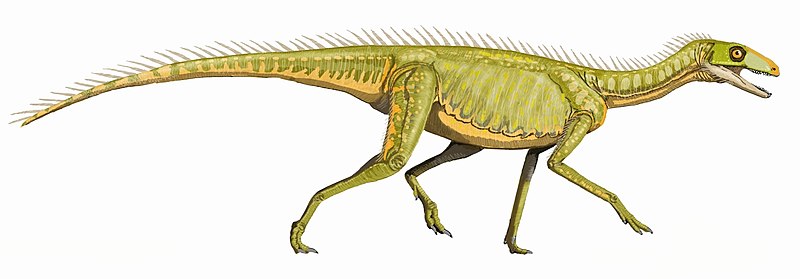













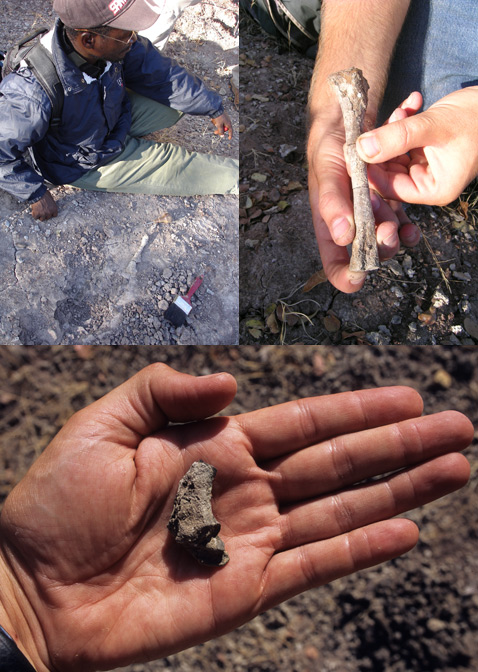
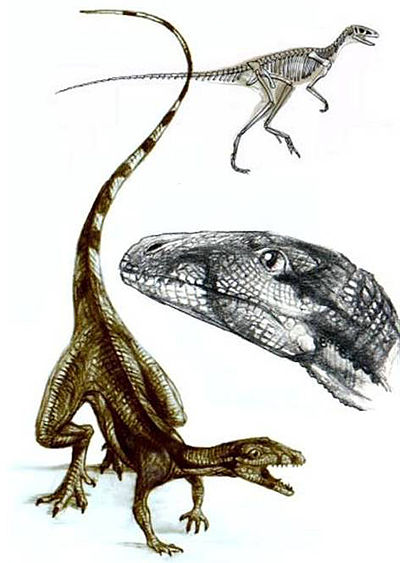
















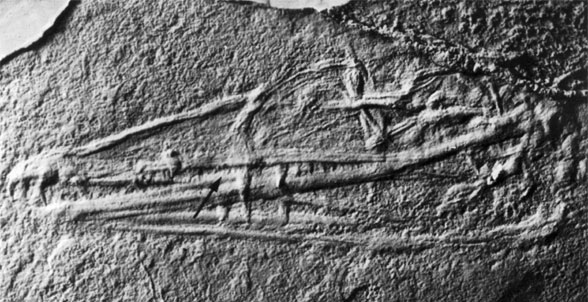









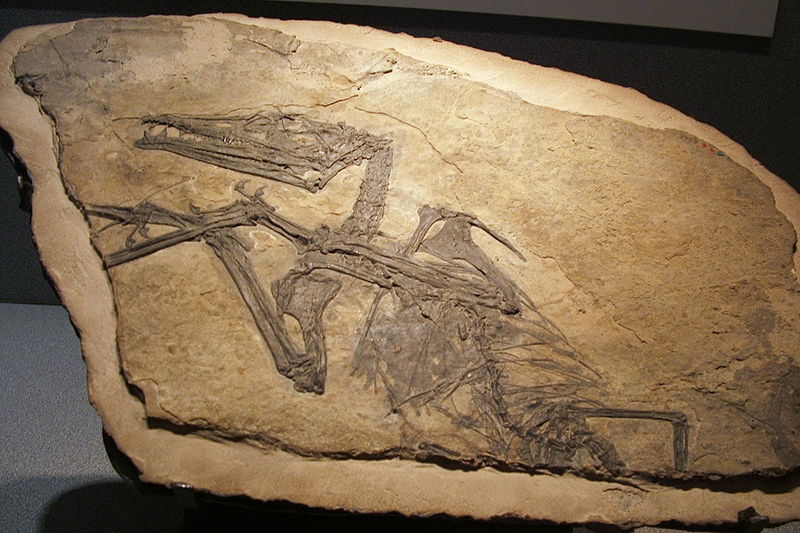
.JPG)







